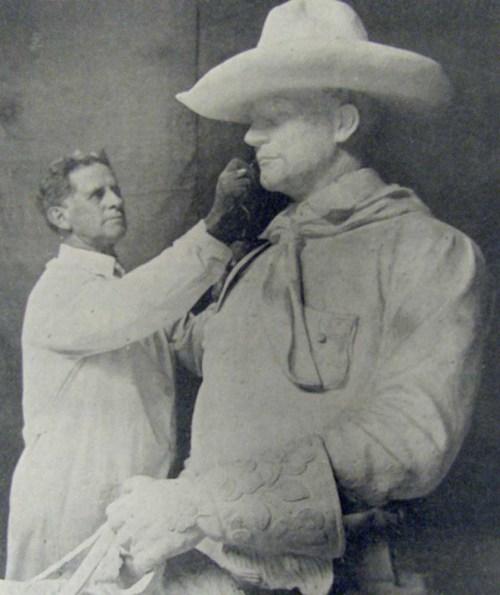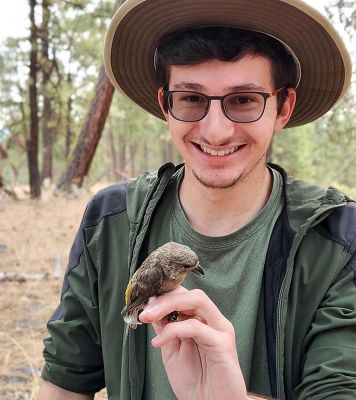Fallen sheriff memorialized in bronze
Published 8:00 am Saturday, August 15, 2020

- A. Phimister Proctor works on details of the Til Taylor statue at his studio in Belgium in 1927.
The little boy stood ready to do his job.
Nine-year-old Till Taylor gripped a cord hooked to a drape over a statue of his grandfather, Sheriff Tillman D. Taylor, killed nine years earlier in a jailbreak at the Umatilla County Jail.
Trending
The day was gray. Behind the towering statue, Sheriff Taylor’s fellow Pendleton Round-Up directors sat on horses and waited. The huge crowd included nearly 200 law enforcement officers, several tribal leaders in full regalia, Oregon Gov. Isaac L. Patterson, sculptor Alexander Phimister Proctor and the sheriff’s widow.
All eyes rested on young Till, who shared a nickname with his grandfather, albeit with an extra “L”.
Till tugged the cord and the cover slipped away. A bronzed Sheriff Taylor sat with his back straight and eyes gazing calmly ahead, atop his favorite horse, Flax. According to historian Sam Pambrun of Athena, the vision of Taylor and Flax came from a Howdyshell Photos image taken during the 1918 Pendleton Round-Up.
The 12-foot-high man and horse stood on a 4-foot marble base near a trio of reflecting pools, one large one in front of the bronze flanked by two smaller pools. According to the East Oregonian, Proctor, a friend of Taylor, started the statue in Rome and completed it in Brussels, where it was cast in bronze. The sheriff’s hat, gloves, saddle and other items were sent to Rome, where they served as models for Proctor. A Sept. 19, 1929, EO story reported that the sculptor and his work in progress had attracted attention from Italian royalty.
“The king and queen of Italy were much interested in the statue and on a visit to Mr. Proctor’s studio asked many questions concerning it. The queen particularly admired the work of showing a saddle rich in carving.”
At the unveiling, Proctor told the crowd, “I did my best and I hope that Pendleton is pleased.”
Trending
Several others spoke at greater length that day. Gov. Patterson talked glowingly of the fallen sheriff.
“He was utterly fearless, with the cool quiet courage that rises above bravado and bluster and that despises useless bloodshed,” Patterson said. “He was too brave a man and too big a man to kill where killing could be avoided. Til Taylor well deserved his title of ‘Oregon’s greatest peace officer.’ His absolute fearlessness, his unquestioned integrity and his unswerving devotion to duty were joined with an amazing ability to trace, locate and identify criminals.”
Four local Indian leaders, all in full regalia, stood on the platform to represent the Tribes. Poker Jim, accompanied by Jim Badroads, Jim Kanine and Amos Pond and interpreter Richard Burke, spoke to the crowd about Taylor.
“When I see a statue of my friend Til Taylor I am thinking that it is known that he is dead, but this statue makes me know he is alive,” Poker Jim said. “He stands here forever and will be here for many generations. I remember he came to our agency when he was president of the Round-Up and it was because he asked us that we brought our camps to the Round-Up.”
It had taken nine years to get to this day. The first donation for the statue, $25, was given five days after the murder in July of 1920. The donations ranged from $500 down to nickels and dimes given by Pendleton children, and totaled more than $20,000.
After the statue arrived by ship to Portland, the Penland Brothers of Pendleton trucked it 230 miles on the Columbia River Highway to its new home at Til Taylor Park.
In 2010, the sheriff’s grandson shared some of his memories of the unveiling with Doug and Cathy Jory, who interviewed him for their unpublished manuscript “From Cheyenne to Pendleton.” Taylor remembered that he got a new pair of boots out of the deal for his role in honoring his grandfather. Some of the other details of the day stuck in his brain as well.
“The band played. Someone had draped a flag over the statue. There was a story going around that when they transported the statue from Italy, it crossed the continent on a flatcar. There was a tunnel with inadequate clearance so they had to cut the top of his hat off to get it through. I don’t know if that was a yarn or the truth. Later on, I remember some of us boys climbing up on the statue and checking to see if his initials were in the same place as they were on his saddle. His initials were there.”
Occasionally there is talk of relocating the statue, the latest in 2018 when the city of Pendleton briefly considered moving it to the site of the new fire station. Taylor’s great-granddaughter Debra Sheard Carter responded with a letter to the editor entitled “Leave Til Taylor Park alone.” Carter got her wish.
Recently, the Athena woman stood at the base of the sun-dappled bronze and gazed up at her great-grandfather.
“I was proud of who he was,” Carter said. “The statue brings him alive.”









